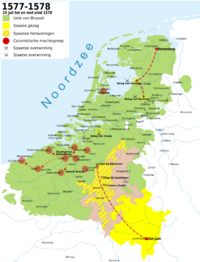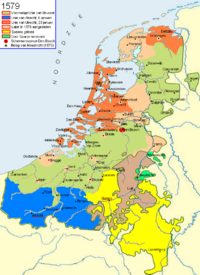Union of Arras facts for kids
| History of the Low Countries | ||||||||
|---|---|---|---|---|---|---|---|---|
| Frisii | Belgae | |||||||
| Cana- nefates |
Chamavi, Tubantes |
Gallia Belgica (55 BC – 5th c. AD) Germania Inferior (83 – 5th c.) |
||||||
| Salian Franks | Batavi | |||||||
| unpopulated (4th–5th c.) |
Saxons | Salian Franks (4th–5th c.) |
||||||
| Frisian Kingdom (6th c.–734) |
Frankish Kingdom (481–843)—Carolingian Empire (800–843) | |||||||
| Austrasia (511–687) | ||||||||
| Middle Francia (843–855) | West Francia (843–) |
|||||||
| Kingdom of Lotharingia (855– 959) Duchy of Lower Lorraine (959–) |
||||||||
| Frisia | ||||||||
Frisian Freedom (11–16th century) |
County of Holland (880–1432) |
Bishopric of Utrecht (695–1456) |
Duchy of Brabant (1183–1430) Duchy of Guelders (1046–1543) |
County of Flanders (862–1384) |
County of Hainaut (1071–1432) County of Namur (981–1421) |
P.-Bish. of Liège (980–1794) |
Duchy of Luxem- bourg (1059–1443) |
|
Burgundian Netherlands (1384–1482) |
||||||||
Habsburg Netherlands (1482–1795) (Seventeen Provinces after 1543) |
||||||||
Dutch Republic (1581–1795) |
Spanish Netherlands (1556–1714) |
|||||||
Austrian Netherlands (1714–1795) |
||||||||
United States of Belgium (1790) |
R. Liège (1789–'91) |
|||||||
Batavian Republic (1795–1806) Kingdom of Holland (1806–1810) |
associated with French First Republic (1795–1804) part of First French Empire (1804–1815) |
|||||||
Princip. of the Netherlands (1813–1815) |
||||||||
| United Kingdom of the Netherlands (1815–1830) | Gr D. L. (1815–) |
|||||||
Kingdom of the Netherlands (1839–) |
Kingdom of Belgium (1830–) |
|||||||
| Gr D. of Luxem- bourg (1890–) |
||||||||
The Union of Arras (also called Unie van Atrecht in Dutch, Union d'Arras in French, and Unión de Arrás in Spanish) was an important agreement made in early 1579. It was an alliance between three areas in the Habsburg Netherlands: the County of Artois, the County of Hainaut, and the city of Douai. This happened during the Eighty Years' War, a long conflict where the Dutch provinces fought for independence from Spain.
The people in Artois, Hainaut, and Douai were not happy with the religious rules set by the rebel leader Prince of Orange and the States General of the Netherlands. They were especially worried about the rise of a strict Protestant group called the Calvinist Republic of Ghent since late 1577.
So, on January 6, 1579, these areas signed a declaration. They promised to strongly defend the Roman Catholic religion against the Calvinists in other provinces. After this, they started talking with the Spanish King to make a separate peace. This led to the Treaty of Arras, signed on May 17, 1579.
Contents
Why the Union of Arras Formed
Before the Union of Arras, all the provinces in the Habsburg Netherlands had joined together. They were united against King Philip II of Spain, who ruled the Netherlands. They formed an agreement called the Pacification of Ghent. This agreement aimed to unite everyone against the Spanish king.
They also created a government called the Union of Brussels. This government had a leader chosen by the provinces, Archduke Matthias. Prince of Orange, a key rebel leader, had a big role in this new government.
One important part of the Pacification of Ghent was about religion. It said that Protestants (Calvinists) could practice their religion freely in Holland and Zeeland. In the other 15 provinces, the Catholic Church was supposed to remain the main religion.
However, Calvinists in other provinces soon wanted religious freedom too. In areas like Flanders and Brabant, they even used force to change city governments. Cities like Ghent, Bruges, and Antwerp saw these changes. This made Catholic politicians in the southern part of the country very unhappy. Prince of Orange tried to create "religious peace" by allowing both Catholics and Protestants to worship freely everywhere. But this idea did not please everyone.
The Declaration of January 6, 1579
In October 1578, the Spanish commander, Don Juan, died. He was replaced by Alexander Farnese, Duke of Parma. Parma was a very skilled diplomat. He was good at finding ways to separate the Catholic nobles in the south from the government led by Prince of Orange.
A group of Catholic nobles, sometimes called "Malcontents," had formed. They were against Prince of Orange's policies. Their leaders were Philip de Lalaing, 3rd Count of Lalaing and Emanuel Philibert de Lalaing. Parma started talking with these Malcontents.
These talks led to an alliance between Hainaut, Artois, and the city of Douai. On January 6, 1579, they signed a declaration. In this document, they expressed their unhappiness with what had happened since the Pacification of Ghent. Without naming Prince of Orange directly, they rejected his idea of "religious peace."
They made a strong promise in their declaration. They swore to protect their "holy Catholic, apostolic, Roman faith." They also promised to obey the King and work for the peace of their homeland. They wanted to keep their old rights, freedoms, and customs. They agreed to resist anyone who tried to go against these goals. To do this, they would help each other and use their lives, bodies, and resources.
This declaration did not create a military alliance like the Union of Utrecht, which northern provinces formed later that month. The signers of the Union of Arras believed they were the "true" defenders of the original Union of Brussels. They intended to continue that union.
The Peace of Arras
The members of the Union of Arras soon began peace talks with Parma. These talks resulted in the signing of the Treaty of Arras (1579) on May 17, 1579.
Here are the main agreements of the Peace of Arras:
- Both the Spanish King and the Union of Arras members agreed to follow the rules of the Pacification of Ghent, the Perpetual Edict, and the Union of Brussels again.
- There would be no more foreign soldiers stationed in the provinces, whether paid by Spain or by the States General.
- The Council of State, a key government body, would be set up like it was during the time of Emperor Charles V.
- Two-thirds of the council members had to be approved by all the states of the member provinces.
- All special rights and freedoms that existed during Emperor Charles V's rule would be brought back.
- Taxes that were added after Emperor Charles V's rule would be removed.
- The Roman Catholic religion would be the only allowed religion. Any other religion, like Calvinism, would be forbidden.
The provinces that signed this peace treaty were:
- County of Hainaut
- County of Artois
- Lille, Douai, and Orchies (which were part of Walloon Flanders)
Some other regions supported the Peace of Arras but did not sign it right away. They joined later. These included:
- County of Namur
- County of Luxembourg
- Duchy of Limburg
Parma used these "reconciled" (peace-making) areas as a base. From there, he started to take back control of the provinces that refused to obey, which were the members of the Union of Utrecht.
See also



